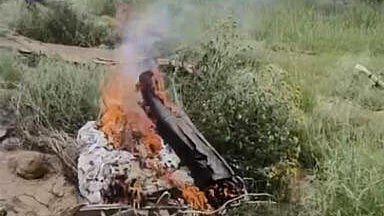
Smoke billows out after IAF's Jaguar fighter jet crashed near Churu in Rajasthan.
Credit: PTI Photo
New Delhi: A Jaguar is a deep penetration strike bomber and a twin-engine jet which is "considered very safe" and only a court of inquiry would tell what went wrong with the aircraft that crashed near Churu in Rajasthan on Wednesday, say aviation experts.
The Jaguar jets were inducted into the Indian Air Force (IAF) in 1979, with an initial batch of aircraft coming from in fly-away condition from the UK.
Two pilots of the IAF were killed on Wednesday in the crash of a Jaguar trainer aircraft, the third such accident since March involving the twin-engine bomber.
The IAF said that a court of inquiry has been constituted to ascertain the cause of the accident.
PTI spoke to some of the former IAF officers, pilots and aviation experts on the importance of Jaguar jets, which have been a key asset of the force for more than four decades.
"A Jaguar is a strike bomber aircraft. Its purpose is air-to-ground strike, it is a deep penetration strike bomber. And, it is a twin-engine aircraft, and thus very safe," said a senior IAF official, requesting anonymity.
The official, also an aviation expert, said that there should be no speculation over the cause of the crash and the court of inquiry would look into it.
A Jaguar jet is "considered very safe", he asserted.
"If something goes down with one engine, there is another engine to take care of it and ensure landing. So, something would have gone wrong (in the incident) and the court of inquiry will tell," he told PTI.
The aircraft has also taken part in flypasts over Kartavya Path (earlier Rajpath) in Delhi during the Republic Day celebrations, reflecting its importance in the IAF fleet.
Another aviation expert and a pilot, who earlier served in the IAF, said one cannot really tell what exactly led to the crash until the inquiry is completed.
Any factor could have led to it, a technical malfunction, a bird hit or any other reason, so imputing the age of a platform as factor would be a premature judgement, the expert said, requesting anonymity.
The Churu crash was the third incident since March involving Jaguar aircraft.
Earlier on March 7, a Jaguar fighter jet crashed following a system malfunction shortly after taking off from the Ambala air base. The pilot had maneuvered the aircraft away from any habitation on ground before ejecting safely.
On April 2, another Jaguar jet crashed at a village near Jamnagar IAF station in Gujarat following a technical snag. The aircraft was on a training mission. One pilot was killed in the accident while the other sustained injuries.
Jaguar is a British-French fighter aircraft that was originally deployed in the British Royal Air Force and the French Air Force. The first flight of the Jaguar took place on September 8, 1968.
The French Air Force flew the jet until July 2005, while the Royal Air Force used it till the end of April 2007.
India, after inducting them in the late 1970s, whose initial batch of aircraft had come in fly-away condition from the UK, had produced others under licence in the country, experts said.
Jaguar aircraft are "absolutely fly-worthy" and they are used for operations, the senior official said.
"All aircraft are safe and airworthy, there is no aircraft which takes off or leaves the ground and not airworthy. It cannot happen. There is a set of rules, a set of engineers, a set of technicians which together decide its airworthiness. There of no question of its being not safe or not airworthy, before it goes for...," he said.
Any aircraft that goes up is "fully serviceable and airworthy", said the official, adding "things can go wrong, we will find it in the court of inquiry".
He also said apart from upgrading of the existing platforms, new ones have been inducted or planned to be inducted and there is a plan for Advanced Medium Combat Aircraft (AMCA) as well.
The Defence Ministry has cleared the "execution model" to design and produce AMCA -- the fifth-generation stealth fighter jet -- by the Hindustan Aeronautics Ltd (HAL) in partnership with private sectors.
India plans to develop five prototypes of the AMCA before undertaking its series production.
The two experts also said that use of phrases like 'flying coffin' by a section of people to describe any aircraft linked with accidents is not appropriate.
Soviet-era MiG-21 has been termed by many as 'the flying coffin' due to number of crashes and resulting loss of lives in the past.
"It also hits the morale of family members of pilots, if such terms are used to describe an aircraft they may be flying," the expert said.